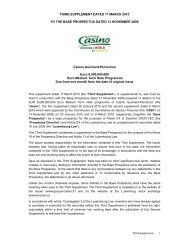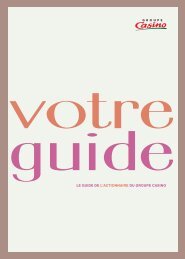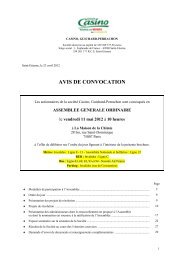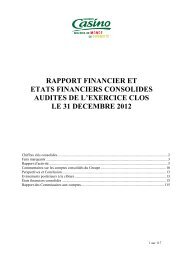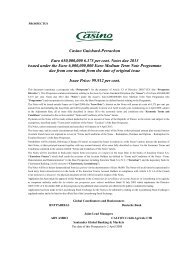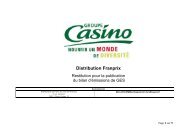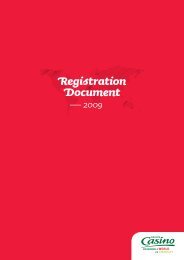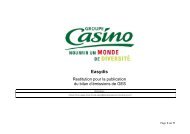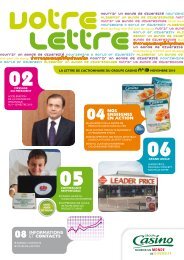2010 REGISTRATION DOCUMENT (3.4 Mo) - Groupe Casino
2010 REGISTRATION DOCUMENT (3.4 Mo) - Groupe Casino
2010 REGISTRATION DOCUMENT (3.4 Mo) - Groupe Casino
You also want an ePaper? Increase the reach of your titles
YUMPU automatically turns print PDFs into web optimized ePapers that Google loves.
CONSOLIDATED FINANCIAL STATEMENTSNotes to the consolidated fi nancial statements3■configuration, competition, ownership method, rental and extensionpotential and comparability with recent transactions), taking intoaccount any difference between actual and market rents for theproperty concerned. Any non-billable expenses and works are thendeducted from this amount;the discounted cash flows (DCF) method consists of discountingfuture revenues from the asset and takes into account, year afteryear, forecast rent adjustments, vacancy rates and other parameterssuch as marketing periods and capital expenditure to be financedby the lessor.The discount rate used is the risk-free market rate (10-year OAT TECfor France) plus a property market risk and liquidity premium, plus apremium for obsolescence and rental risk if applicable.Small assets are also valued by comparison to transactions in similarassets.Note 1.5.11. Cost of f ixed assetsThe cost of fixed assets corresponds to their purchase cost plustransaction expenses including tax.Note 1.5.12. Impairment of non-current assetsThe procedure to be followed to ensure that the carrying amount ofassets does not exceed their recoverable amount (recovered by useor sale) is defined in IAS 36.Goodwill and intangible assets with an indefinite useful life are testedfor impairment at least once a year. Other assets are tested wheneverthere is an indication that they may be impaired.Note 1.5.12.1. Cash Generating Units (CGUs)A cash-generating unit is the smallest identifiable group of assetsthat generates cash inflows that are largely independent of the cashinflows from other assets or groups of assets.The Group has defined cash-generating units as follows:■■for hypermarkets, supermarkets and discount stores, each storeis treated as a separate CGU;for other networks, each network represents a separate CGU.Note 1.5.12.2. Impairment indicatorsApart from the external sources of data monitored by the Group(economic environment, market value of the assets, etc.), theimpairment indicators used are based on the nature of the assets:■■■land and buildings: loss of rent or early termination of a leasecontract;fixed assets related to the business (assets of the cash generatingunit): ratio of net book value of the assets related to a store dividedby sales (including VAT), higher than a defined level determinedseparately for each store category;assets allocated to administrative activities (headquarters andwarehouses): the closing of a site or the obsolescence of equipmentused at the site.Note 1.5.12.3. Recoverable amountThe recoverable amount of an asset is the higher of its fair value lesscosts to sell and its value in use. It is generally determined separatelyfor each asset. When this is not possible, the recoverable amount ofthe group of CGUs to which the asset belongs is used.Fair value less costs to sell is the amount obtainable from the saleof an asset in an arm’s length transaction between knowledgeable,willing parties, less the costs of disposal. In the retailing industry, fairvalue less costs to sell is generally determined on the basis of a salesor EBITDA multiple.Value in use is the present value of the future cash flows expectedto be derived from continuing use of an asset and from its ultimatedisposal. It is determined internally or by external experts on thebasis of cash flow projections contained in business plans or budgetscovering no more than five years. Cash flows beyond the projectionperiod are estimated by applying a constant or decreasing growthrate. The discount rate corresponds to long-term after-tax marketrates reflecting market estimates of the time value of money and thespecific risks associated with the asset. The terminal value is generallydetermined on the basis of a multiple of final year EBITDA.For goodwill impairment testing purposes, the recoverable amounts ofCGUs or groups of CGUs are determined annually at the year end.Note 1.5.12.4. ImpairmentAn impairment loss is recognised when the carrying amount of anasset or the CGU to which it belongs is greater than its recoverableamount. Impairment losses are recorded as an expense under “Otheroperating income and expense”.Impairment losses recognised in a prior period are reversed if, andonly if, there has been a change in the estimates used to determinethe asset’s recoverable amount since the last impairment loss wasrecognised. However, the increased carrying amount of an assetattributable to a reversal of an impairment loss may not exceed thecarrying amount that would have been determined had no impairmentloss been recognised for the asset in prior years. Impairment losseson goodwill cannot be reversed.Note 1.5.13. Financial assetsNote 1.5.13.1. Defi nitionsFinancial assets are classified into four categories according to theirtype and intended holding period, as follows:■■■■held-to-maturity investments;financial assets at fair value through profit or loss;loans and receivables;available-for-sale financial assets.Financial assets are classified as current if they are due in less thanone year and non-current if they are due in more than one year.Note 1.5.13.2. Recognition and measurementof fi nancial assetsWith the exception of financial assets at fair value through profit orloss, all financial assets are initially recognised at cost, correspondingto the fair value of the consideration paid plus transaction costs.Note 1.5.13.3. Held-to-maturity investmentsHeld-to-maturity investments are fixed income securities that theGroup has the positive intention and ability to hold to maturity. Theyare measured at amortised cost using the effective interest method.Amortised cost is calculated by adding or deducting any premium ordiscount over the remaining life of the securities. Gains and losses arerecognised in the income statement when the assets are derecognisedor there is objective evidence of impairment, and also through theamortisation process.Registration Document <strong>2010</strong> | <strong>Casino</strong> Group67



